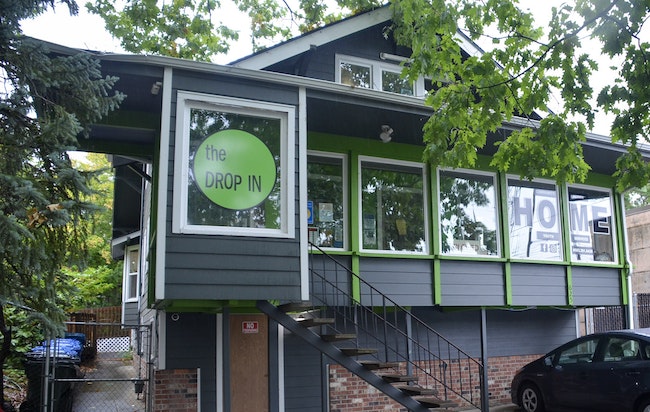
The HOME Youth and Resource Center on Union Street Northeast (Rachel Alexander/Salem Reporter)
The hundreds of young people experiencing homelessness in Salem struggle to find a safe place to sleep with only two shelters and adults’ unwillingness to let them stay in homeless camps.
That’s according to feedback given by local youth in a grant application to get more federal funding to combat youth homelessness in Marion and Polk counties.
On Sept. 15, the federal Department of Housing and Urban Development announced the Mid-Willamette Valley Homeless Alliance was awarded $3.7 million through the Youth Homelessness Demonstration Program. It was the first time the region has been successful in getting the funding.
Carla Munns, a consultant with the alliance, credits that success to feedback from local teens and young adults experiencing homelessness on what they see as necessary.
“This grant would not have been awarded if it wasn’t for youth and the engagement and info they provided,” she said.
Now, the alliance will spend the next six months alongside Backbone, the local Youth Action Board, and a Youth and Young Adults Subcommittee to create a community plan to prevent and end youth homelessness. It will outline how they plan to spend the federal money.
The alliance is the Marion/Polk region’s Continuum of Care, a regional planning group created in 2019 that’s mission is “to develop an evidence-based system of services, including stable housing, designed to meet the unique and complex needs of adults, youth, children, and families in Marion and Polk counties who are at risk of or are experiencing homelessness.”
The Youth Action Board, Backbone, is a youth-led group that shares their lived experience to impact youth homelessness and influence policy making decisions. The youth subcommittee meets monthly to go over goals related to young people experiencing homelessness.
In a letter to HUD, Backbone members said they were “stoked” to receive the funding.
“Our ultimate goal is that no youth will ever have to experience homelessness and the vast traumas associated with it. We were forced to grow a strong ‘backbone’ at a young age due to the realities of unstable housing and lack of options for youth,” the letter said.
More than 2,000 students attending public school in Marion and Polk counties identified as homeless in 2019-2020, 16% of whom were unaccompanied minors and 10% of whom were unsheltered.
The students were classified as homeless under the McKinney-Vento Act, a federal grant program for homeless students that helps pay for homeless liaisons, transportation and other items, such as school supplies.
According to Oregon Department of Education for the 2019-2020 school year, Falls City School District had the highest percentage of homeless students in the entire state, with one in four students experiencing homelessness there.
Youth homelessness is counted differently than adult homelessness under the act, with students who are doubling up, or sharing housing, included in the count. Young people often “couch surf.”
Munns said the community is making strides in a host home program, which gives families and adults resources to help youth that might be staying with them.
She gave as an example a young person staying with a friend or family member.
“They don’t have any legal right to have them stay at their home if parents don’t give permission,” she said.
The host home program can help give those adults get temporary guardianship.
Munns said there’s a large gap in services. Out of 2,000 homeless students counted, which she said is an undercount, there is only one overnight shelter serving minors.
Taylor’s House opened in Dec. 2018 as a home for teens and young people between 11 and 18 who are homeless or in foster care and don’t have another place to go. It has space for 10.
Northwest Human Services HOST program, which has transitional housing for young adults aged 18 to 24, has 14 beds.
In Polk County, there are no shelters available for youth specifically.
Munns said youth have unique barriers to getting served. It could be a lack of identifying documents, being unable to get a cell phone plan, housing or they don’t have experience navigating complex systems like healthcare.
“Before working directly with the youth I had no idea some of the barriers they experienced,” she said.
Munns said a young person could be fleeing their family because it’s unsafe to stay with them, but family members may refuse to give them their birth certificate, so they can’t rent an apartment.
She said she was surprised to learn youth are often shunned from adult homeless encampments.
“When they go to a homeless camp, adults see them as a runaway and the police are going to be looking for them,” she said. “They shun the youth and subsequently don’t have anywhere to camp that’s safe and approved by the city.”
Munns was referring to an emergency order which allowed camping in Wallace Marine Park and Cascades Gateway Park during the pandemic. That gradually ended by August.
In addition, many young women on the street are sexually assaulted, Munns said.
She said the impact of constantly being in fight or flight mode, not having basic needs met, means young people’s brains aren’t able to fully develop properly. Youth homelessness is a significant factor for adult homelessness, with 70% of people experiencing homelessness in the area reporting they experienced some form of homelessness as a kid.
But Munns describes the young people she works with as resilient.
“They are so strong and so capable,” she said.
Contact reporter Saphara Harrell at 503-549-6250, [email protected].
JUST THE FACTS, FOR SALEM – We report on your community with care and depth, fairness and accuracy. Get local news that matters to you. Subscribe to Salem Reporter starting at $5 a month. Click I want to subscribe!









